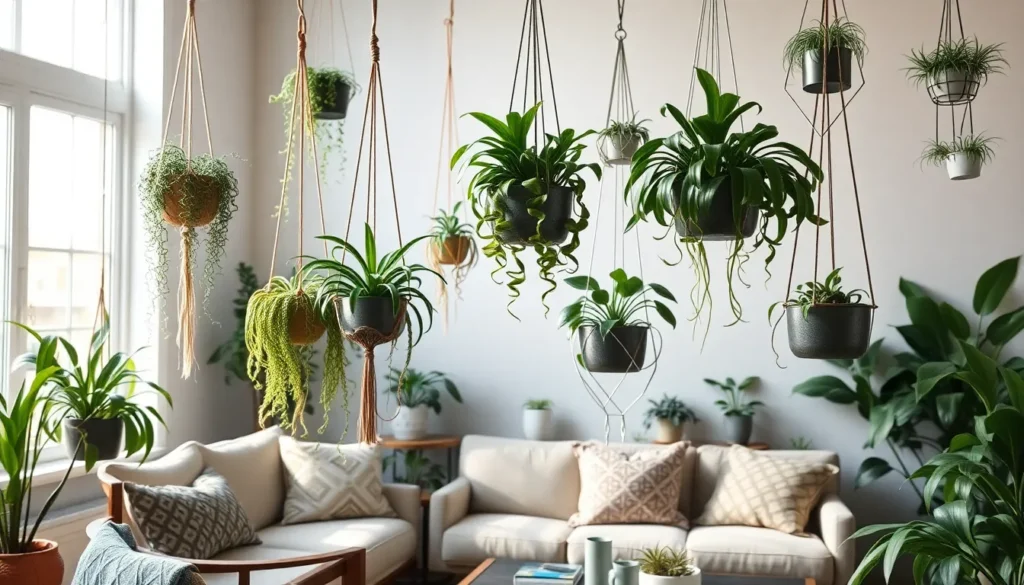We’ve all experienced that moment when we walk into a living room and something feels missing. The furniture’s perfect the lighting’s just right but the space lacks that organic warmth that makes a house feel like home. Hanging plants might be exactly what your living room needs to transform from ordinary to extraordinary.
These suspended green beauties don’t just purify your air – they create stunning visual layers that draw the eye upward and make any space feel more ever-changing. Whether you’re working with a cozy apartment or a spacious family room hanging plants offer an innovative solution for adding life without sacrificing precious floor space.
From cascading pothos that create natural curtains to sculptural air plants that serve as living art pieces we’re diving into how hanging plants can revolutionize your living room design. You’ll discover the best varieties for different lighting conditions plus practical tips for creating your own elevated garden sanctuary.
Choose the Perfect Hanging Plants for Your Living Room Space
Selecting the right hanging plants transforms your living room into a verdant sanctuary that suits your exact needs and lifestyle. We’ll guide you through three essential categories to help you make informed decisions for your elevated garden space.
Low-Light Varieties That Thrive Indoors
Pothos plants excel in dimly lit living rooms where natural light is limited. These cascading beauties adapt to fluorescent lighting and can survive in corners that receive minimal sunlight throughout the day. Golden pothos and marble queen varieties offer stunning foliage patterns that brighten dark spaces with their variegated leaves.
ZZ plants (Zamioculcas zamiifolia) create dramatic vertical interest with their glossy dark green stems. They tolerate neglect exceptionally well and actually prefer indirect light over bright conditions. We recommend placing them near north-facing windows or in interior corners where other plants might struggle.
Snake plants work beautifully in macrame hangers due to their architectural upright growth pattern. Sansevieria varieties filter air pollutants while requiring watering only once every two to three weeks. Their striking yellow-green striped leaves add modern elegance to contemporary living room designs.
Philodendrons offer heart-shaped leaves that cascade gracefully from hanging baskets. Brazil philodendrons and heartleaf varieties thrive in low to medium light conditions found in most living spaces. These plants grow quickly once established and create lush green curtains that soften harsh architectural lines.
Pet-Safe Options for Family Homes
Spider plants (Chlorophytum comosum) produce charming plantlets that dangle like natural ornaments from the mother plant. They’re completely non-toxic to cats and dogs while being incredibly easy to propagate. Boston ivy and spider plant babies can be shared with friends or used to fill additional hanging spots throughout your home.
Boston ferns create feathery, delicate textures that complement both traditional and modern living room decor. These air-purifying plants are safe for curious pets and children who might nibble on trailing fronds. They prefer consistent moisture and humidity, making them perfect for living rooms with regular activity.
Ponytail palms (Beaucarnea recurvata) offer unique sculptural appeal with their bulbous trunks and fountain-like foliage. Even though their exotic appearance, they’re completely safe for pets and require minimal watering. Their drought-tolerant nature makes them ideal for busy families who travel frequently.
Prayer plants (Maranta leuconeura) display stunning patterned leaves that fold upward at night like praying hands. They’re pet-friendly and thrive in the warm, humid conditions typical of active living spaces. Red-veined and lemon-lime varieties add colorful accents without compromising family safety.
Fast-Growing Plants for Quick Results
Tradescantia plants explode with growth in just weeks, creating full, trailing displays in record time. Purple heart and zebrina varieties produce vibrant purple and silver foliage that fills hanging baskets within a single growing season. These prolific growers need regular pinching to maintain their shape and encourage bushier growth.
Inch plants (Tradescantia zebrina) develop new growth daily when provided with bright, indirect light. They root easily in water, allowing you to propagate cuttings for additional hanging displays throughout your living room. Their fast growth rate means you’ll see dramatic changes weekly rather than monthly.
Swedish ivy races across hanging basket edges, creating waterfall effects in just two to three months. This vigorous grower produces small white flowers and aromatic leaves that release pleasant scents when touched. Regular trimming encourages fuller growth and prevents the plant from becoming too leggy.
Heartleaf philodendron vines can grow several feet in a single season with proper care. New leaves emerge bright green and darken as they mature, creating beautiful color gradients along trailing stems. These rapid growers benefit from monthly fertilizing during spring and summer to support their aggressive growth patterns.
Select the Right Hanging Planters and Containers
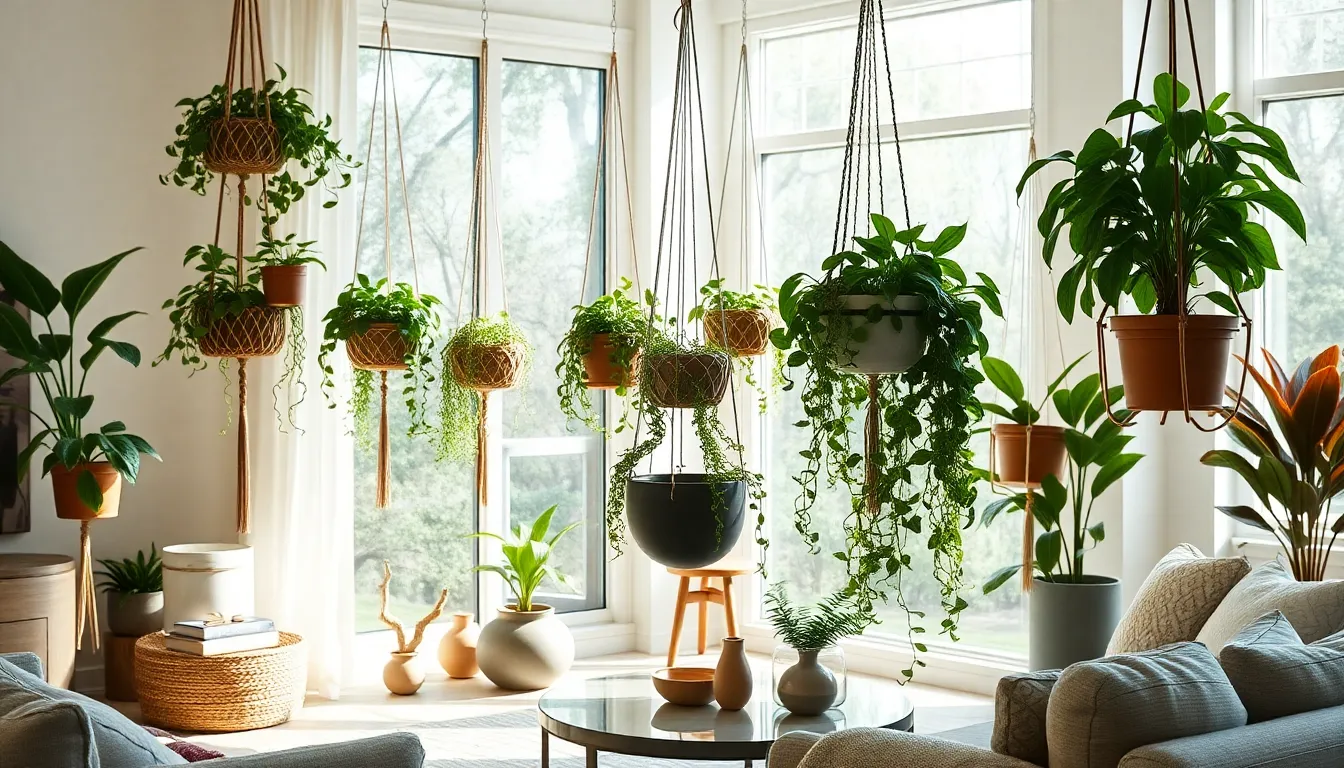
Choosing the perfect containers for our hanging living room plants requires balancing aesthetics with functionality. We’ll need to consider our space’s lighting conditions, humidity levels, and décor style when selecting planters that’ll showcase plants like pothos, spider plants, string of pearls, Boston ferns, and heartleaf philodendrons.
Macrame Hangers for Bohemian Style
Macrame plant hangers bring a handmade, bohemian aesthetic that transforms our living room into a cozy sanctuary. These woven creations add texture and visual interest while perfectly suspending trailing plants from ceilings or wall hooks.
Their sturdy construction supports various pot sizes, making them ideal for showcasing cascading varieties like pothos or ivy. We can create ever-changing hanging displays at different heights using these artisanal pieces that complement both modern and traditional décor schemes.
The natural fibers in macrame hangers blend seamlessly with wooden furniture and earth tone palettes. These versatile holders work exceptionally well in spaces where we want to emphasize organic textures and handcrafted elements.
Modern Metal and Ceramic Options
Sleek metal planters feature geometric shapes and clean lines that suit contemporary living rooms perfectly. These containers often come in finishes like matte black, brushed gold, or copper that add sophistication to our plant displays.
Ceramic pots offer polished elegance with finishes ranging from matte to glossy in countless colors. We can easily blend these containers into our existing décor schemes while creating striking focal points with their smooth surfaces.
Both materials provide durability and visual impact that elevates our hanging plant arrangements. Metal options tend to be lighter than ceramics, though both create stunning modern displays when paired with architectural plants or trailing varieties.
Weight Considerations for Safety
Ceiling hooks and wall mounts must be securely installed and rated to carry the combined weight of our planter, soil, and fully grown plant. We should always use sturdy hardware like anchors and S-hooks to prevent accidents, especially with heavier ceramic or metal containers.
Distributing weight evenly becomes crucial when grouping multiple hanging plants at various heights. This prevents strain on any single fixture while maintaining visual balance throughout our living room display.
Small planters work best for succulents and compact plants, while larger hanging baskets accommodate trailing species that add lushness to our space. We’ll need to match container size to our plant’s growth potential and our ceiling’s weight capacity.
Determine the Best Locations for Hanging Plants Living Room Displays

Selecting the right location for your hanging plants is crucial for both plant health and creating stunning visual displays. We’ll explore the three most effective placement strategies that maximize both natural light exposure and aesthetic impact.
Near Windows for Natural Light
Windows provide the ideal backdrop for most hanging plants since they require ample natural light to thrive. South-facing windows offer bright, indirect sunlight that suits a wide variety of houseplants including succulents and cacti. East-facing windows deliver gentle morning light that helps plants maintain their vibrant green color and encourages healthy growth.
Curtain rods become dual-purpose fixtures when we use them to hang trailing plants near windows. This placement enhances the aesthetic impact while ensuring plants receive the light they need for photosynthesis. We can position multiple plants at varying heights to create a cascading effect that frames the window beautifully.
Corner Spaces to Maximize Floor Area
Empty corners transform into lush vertical gardens when we strategically place hanging plants in these underutilized areas. Corners draw the eye upward and fill space vertically without cluttering tables or valuable floor space. Plants with trailing or cascading foliage like English ivy work exceptionally well in corner locations.
This placement method adds dimension to our living room while softening sharp angles that can make spaces feel harsh. We create cozy, inviting atmospheres by utilizing corner spaces that would otherwise remain empty and visually dead.
Above Furniture for Layered Greenery
Furniture placement becomes an opportunity for creating layered greenery when we hang plants above sofas, shelves, or side tables. This layering technique gives depth and texture to our living room décor while defining spaces in open-plan layouts. Plants suspended above furniture create natural partitions without blocking light or important sightlines.
We maintain plants at eye level or above without occupying valuable surface area on tables and shelves. Choosing plants that don’t require excessive sunlight or frequent watering like pothos or snake plants ensures easier maintenance for these elevated positions. This strategic placement keeps our living spaces organized while maximizing the visual impact of our plant displays.
Install Proper Hardware and Support Systems
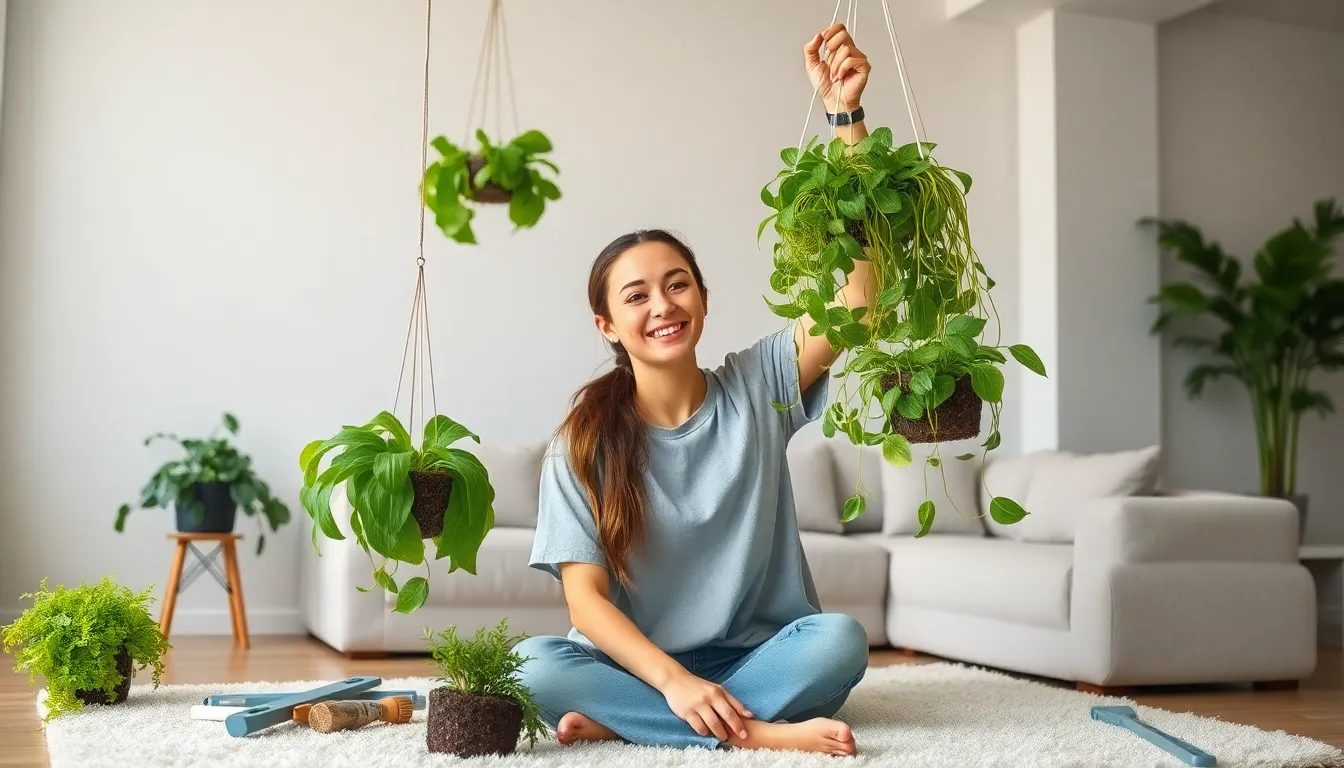
Securing your hanging plants properly ensures they’ll thrive safely in your living room for years to come. We’ll walk you through the essential installation methods and support strategies that protect both your plants and your home.
Ceiling Hook Installation Methods
Finding the right anchor point starts with using a stud finder to locate ceiling joists. These structural beams provide the strongest support for your hanging plants and prevent dangerous failures. We never recommend screwing hooks directly into drywall or plaster alone since these materials can’t handle the weight of water-saturated plants.
Drilling pilot holes prevents cracking and makes installation smoother. Use a drill bit slightly smaller than your screw diameter to create clean entry points. This preparation step ensures your ceiling material won’t split when you install the hardware.
Screwing the hook tightly into the pilot hole creates a secure mounting point. For heavier plants exceeding 10 pounds when watered, we recommend toggle bolts that spread the load across a wider ceiling area. These specialized fasteners work exceptionally well in hollow ceilings where joists aren’t available.
Testing the installation by gently pulling on the hook confirms its stability. We always verify our hardware can support at least twice the expected plant weight before hanging anything valuable.
Wall-Mounted Bracket Options
Wall brackets designed specifically for hanging plants offer versatile mounting answers. We prefer models that anchor directly into wall studs for maximum support capacity. These brackets can handle substantial weight while adding decorative appeal to your living room design.
Heavy duty wall anchors work when studs aren’t conveniently located. Toggle anchors and molly bolts distribute weight across larger wall areas compared to standard screws. We always check manufacturer weight limits and choose anchors rated for at least 150% of our plant’s total weight.
Decorative bracket styles complement different room aesthetics beautifully. Minimalist metal designs suit modern spaces while ornate wrought iron options enhance traditional decor. We select brackets that support our plants functionally while improving the overall visual appeal.
Weight Distribution Guidelines
Calculating total plant weight includes the container, soil, and water content. A medium hanging plant can weigh 15-25 pounds when fully watered, significantly more than its dry weight. We factor in this water weight when selecting hardware and planning installations.
Distributing heavy plants across multiple support points reduces stress on individual anchors. Two ceiling hooks connected with a spreader bar can safely support plants exceeding 30 pounds. This approach prevents concentrated load points that could cause hardware failure.
Regular maintenance checks ensure continued safety and plant health. We inspect all hardware monthly for signs of loosening, corrosion, or wear that could indicate potential problems. Tightening loose connections and replacing worn components prevents accidents and keeps our hanging garden secure.
Create Stunning Visual Arrangements with Multiple Plants
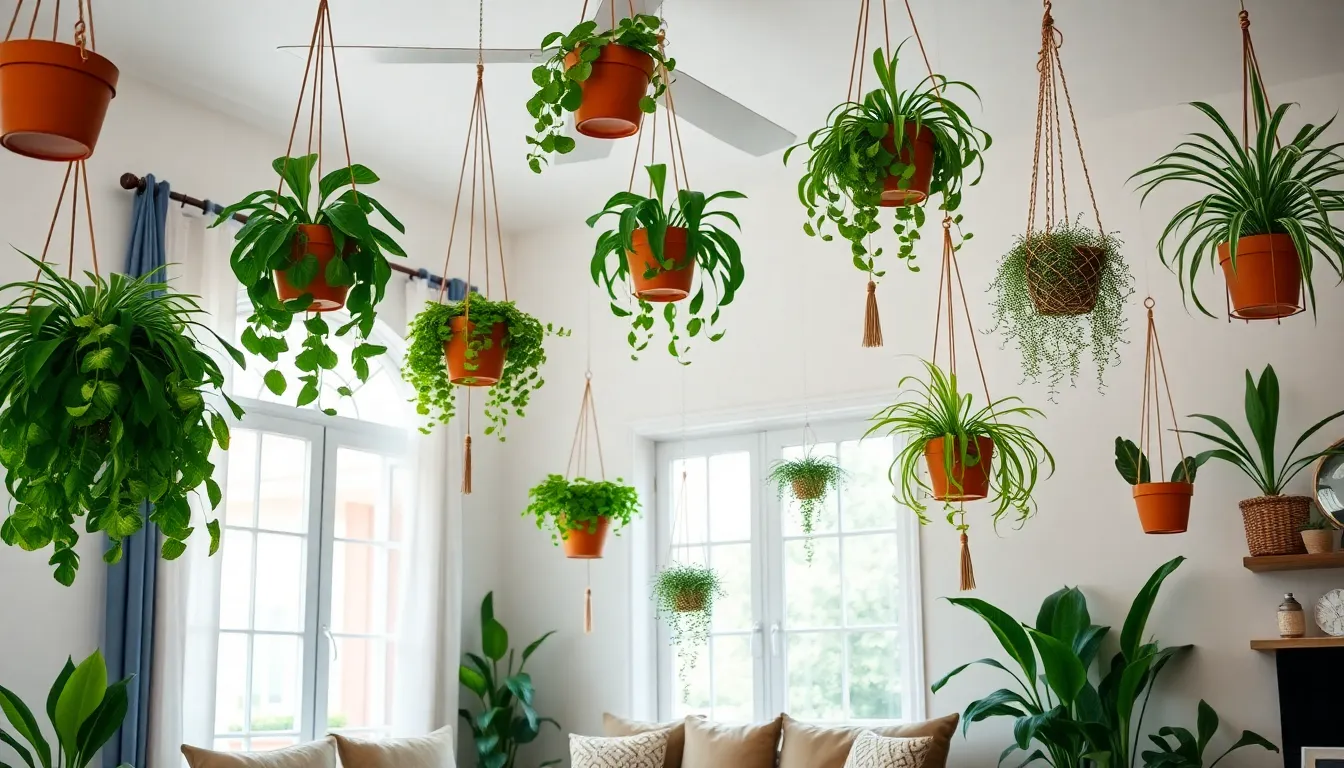
Multiple hanging plants transform living room spaces into lush, green displays that elevate any corner or wall area. Combining several plants creates depth and visual richness that single specimens simply can’t achieve.
Varying Heights for Ever-changing Appeal
Suspending plants at different heights adds dimension and creates artistic layered looks throughout your living room. We recommend hanging baskets or pots at varying levels using ceiling hooks, curtain rods, or wall brackets for versatile placement options.
Different hanging methods support plants of various sizes and shapes while maintaining visual interest. Ceiling installations work perfectly for trailing species like pothos and philodendron, while wall brackets accommodate heavier specimens like Boston ferns.
Staggered heights create natural flow patterns that guide the eye upward and around your space. The layered approach transforms flat walls into ever-changing vertical gardens that serve as living artwork.
Color Coordination with Existing Decor
Matching pot colors and styles to your existing decor creates cohesive aesthetics that enhance your living room’s overall design. We suggest selecting containers in terracotta, ceramic, or woven macrame holders that harmonize with your room’s color scheme.
Seasonal or blooming plants provide perfect pops of color that complement your interior tones. Small flowering hanging plants or succulents in individual terracotta pots brighten spaces while maintaining design continuity.
Container materials should reflect your room’s style preferences and functional needs. Modern metal planters suit contemporary spaces, while natural fiber baskets complement bohemian or rustic decor themes.
Grouping Plants by Care Requirements
Plants with similar light and water needs should be grouped together for efficient maintenance and optimal growth. We recommend clustering low-light tolerant species like ivy in shadier areas while positioning sun-loving plants like hoya near windows.
Strategic placement ensures each plant receives appropriate care without complicating your maintenance routine. Light-loving specimens thrive near windows or spots with ample sunlight, while shade-tolerant varieties fill darker corners effectively.
Similar watering schedules make plant care more manageable when species are grouped appropriately. This approach maximizes plant health while minimizing the time and effort required for daily maintenance tasks.
Maintain Your Hanging Plants Living Room Garden
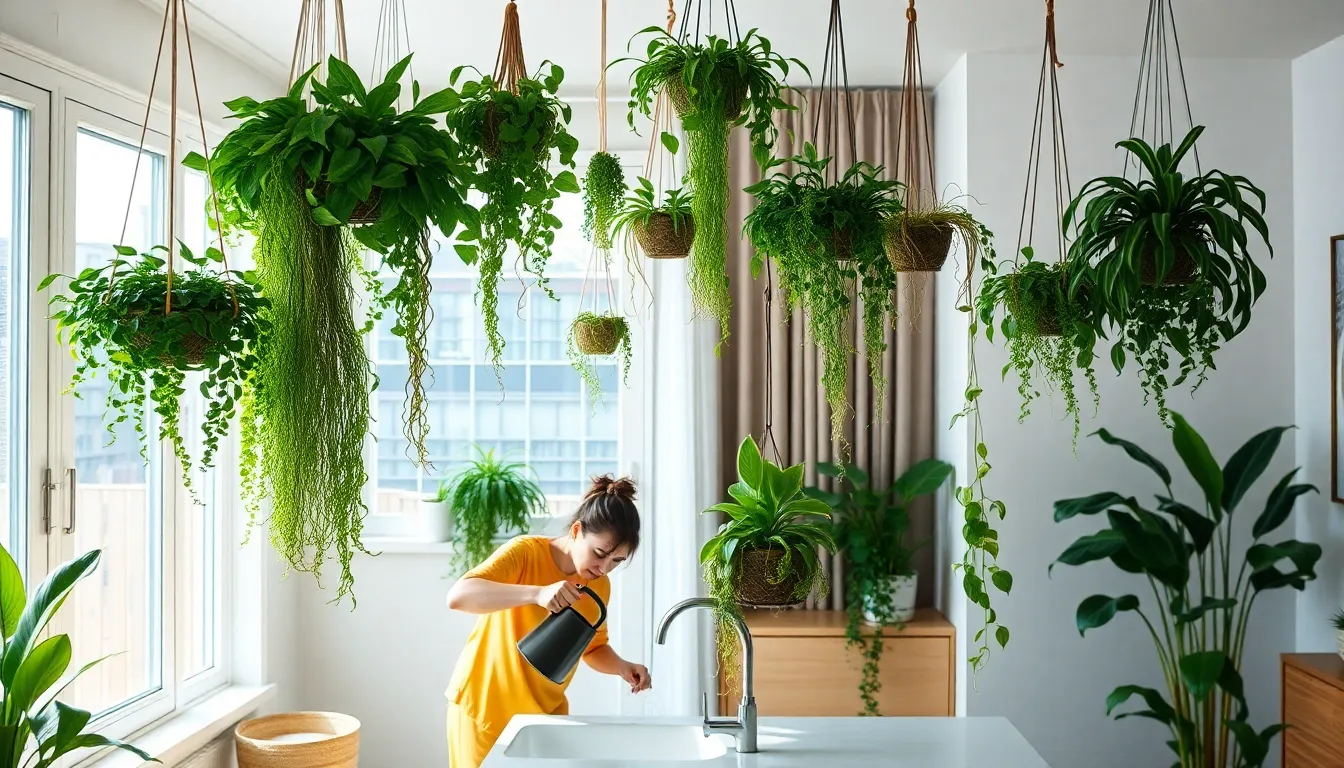
Once we’ve created our elevated garden sanctuary, keeping our hanging plants healthy requires exact techniques that work with their unique positioning and growing conditions.
Watering Techniques Without Mess
Hanging plants dry out faster than traditional floor planters, making consistent watering essential for their survival. Check the top inch of soil before watering to prevent overwatering and root rot that can kill our plants.
Water over a sink or use a narrow spout watering can for precise control when hydrating our elevated garden. Position saucers beneath pots or choose hanging baskets with built in drip trays to catch excess water before it reaches our furniture.
Install a pulley system for easy lowering and watering that minimizes drips or spills inside our living room space. Time watering sessions in the morning to allow plants to absorb moisture throughout the day while reducing nighttime humidity issues.
Pruning and Trimming for Shape
Regular pruning maintains attractive shapes while encouraging fuller, bushier growth in our hanging plants living room display. Trim leggy or overgrown stems to promote branching that creates denser, more appealing plant forms.
Remove yellowing or dead leaves immediately to improve plant health and maintain the visual appeal of our elevated garden. Schedule pruning during spring and summer when most plants experience active growth periods for optimal recovery.
Cut just above leaf nodes to encourage new growth points that will fill out sparse areas in our hanging arrangements. Rotate plants quarterly while pruning to ensure even growth on all sides of our living room garden.
Seasonal Care Adjustments
Spring and summer months require feeding our hanging plants with balanced, water soluble fertilizer every 4 to 6 weeks for optimal growth. Reduce fertilization in fall and winter when plants enter dormancy periods and need fewer nutrients.
Increase humidity during dry months for tropical varieties by misting or using a humidifier, especially when indoor heating systems dry the air. Adjust watering frequency according to temperature changes since plants need less water during cooler months.
Monitor light conditions as seasonal sun angles change and move plants closer to or farther from windows as needed. Group plants with similar care requirements together to simplify our maintenance routine throughout the year.
Style Your Space with Complementary Decor Elements
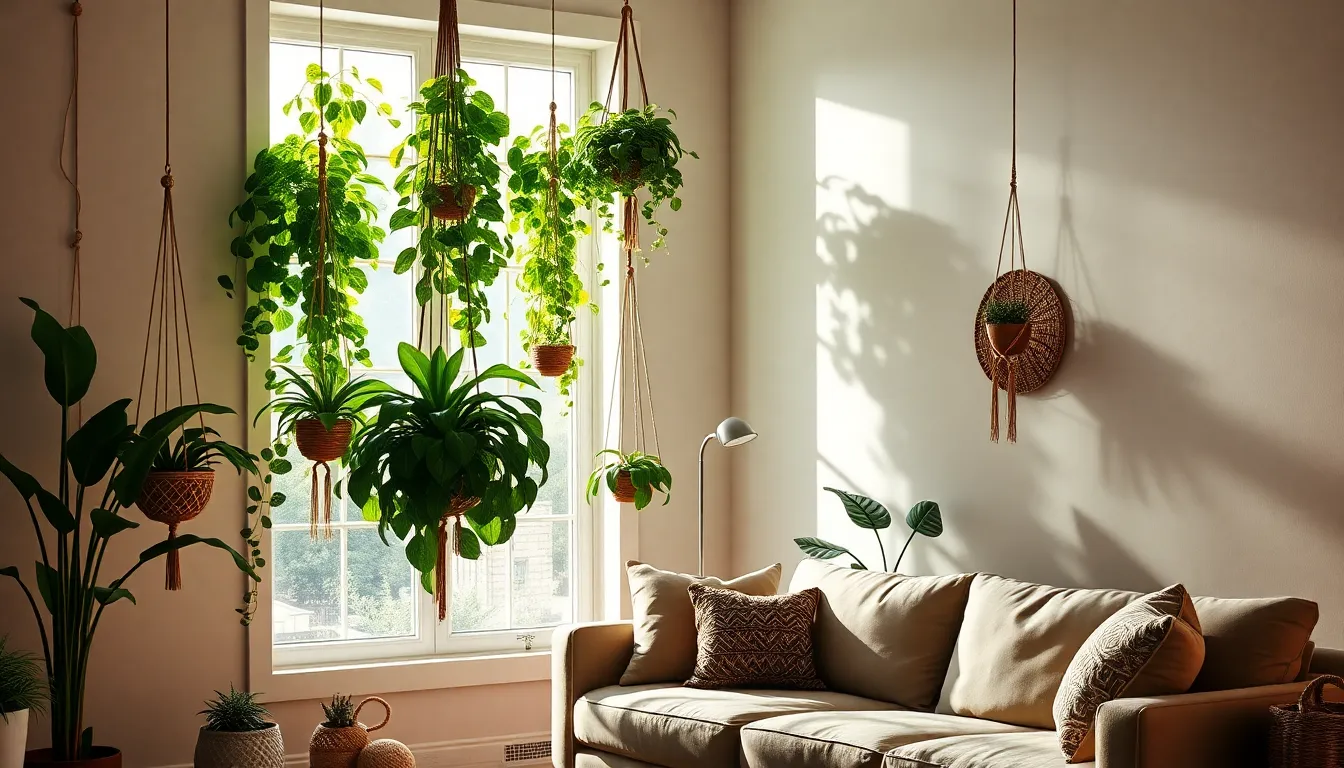
We can transform our living room into a cohesive botanical retreat by carefully selecting decor elements that enhance our hanging plants’ natural beauty. The key lies in choosing pieces that complement rather than compete with our elevated greenery.
Lighting to Enhance Plant Features
Positioning our hanging plants near windows or areas with abundant indirect natural light promotes healthy growth, especially for light-loving species like English ivy and hoya. We can use curtain rods to suspend plants directly in front of windows, creating an attractive green curtain that maximizes sunlight exposure while adding privacy to our space.
Supplementing natural light with soft, warm artificial lighting elevates our plants’ visual impact during evening hours. LED grow lights or strategically placed lamps highlight the unique textures and colors of our trailing foliage, creating dramatic shadows and depth throughout the room. We should focus the lighting upward toward the plants to showcase their cascading forms without creating harsh glare.
Furniture Placement Around Hanging Gardens
Arranging our seating and furniture away from hanging plants prevents accidental disturbance while allowing the trailing tendrils to grow freely in low-traffic zones. We can position sofas or chairs beneath or adjacent to our suspended gardens, creating a layered, immersive effect that draws the eye upward through multiple levels of greenery.
Using hanging plants to fill unused vertical space opens up floor area for essential furniture pieces while maintaining our room’s functionality. Incorporating shelves or wall brackets near seating areas elevates smaller hanging plants, connecting our furniture layout with natural elements and creating visual continuity throughout the space.
Accent Pieces That Complement Greenery
Macrame holders, hanging baskets, and terracotta pots add texture and visual interest to our plant displays while reinforcing the natural aesthetic. We should coordinate these containers with our existing decor by selecting materials like wood or rattan that echo our furniture choices and maintain color harmony.
Textured elements such as woven baskets, natural fiber rugs, and ceramic pots introduce warmth and depth to complement our hanging gardens. Soft greens, earthy tones, and neutral shades in cushions, throws, and curtains harmonize beautifully with plant foliage while creating a cohesive color palette throughout our living space.
Small decorative items like wooden beads in macrame hangers or stylish metal hooks provide subtle artistry that enhances our plants without overwhelming them. We can incorporate accent pieces like decorative plant stands, woven storage baskets, or small sculptures that support the botanical theme while adding personality to our elevated garden sanctuary.
Troubleshoot Common Hanging Plant Problems
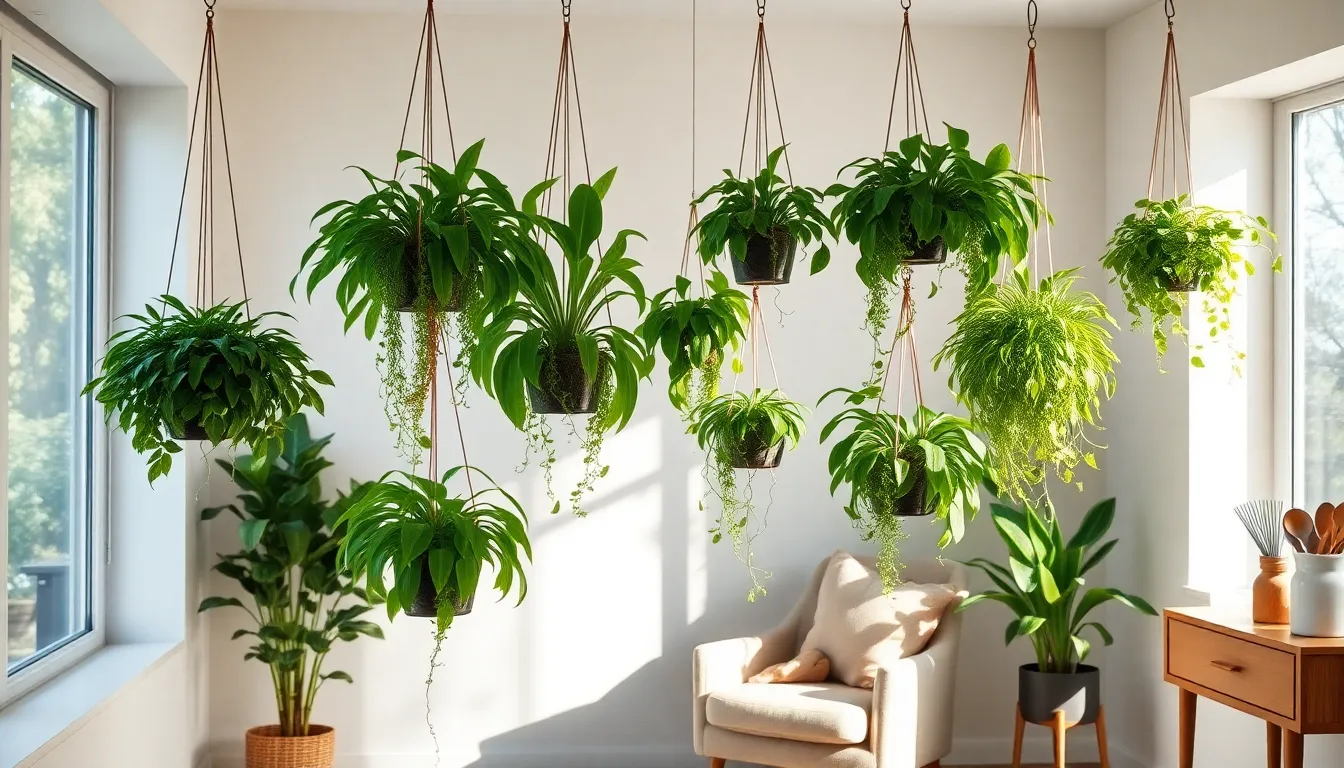
Even the most beautiful hanging plants living room displays can encounter challenges that require quick answers. We’ll address the most common issues and provide practical fixes to keep your elevated garden thriving.
Preventing Water Damage to Floors
Waterproof protection becomes essential when caring for hanging plants since excess drainage can damage sensitive flooring materials. Place waterproof trays or mats directly underneath each hanging plant to catch inevitable drips and prevent costly floor repairs.
Strategic watering techniques help minimize water runoff that threatens your living room floors. Water your plants only when soil feels dry to the touch, ensuring pots have adequate drainage holes to prevent soggy conditions that lead to root rot.
Drip tray installation offers the most reliable protection for wooden and laminate floors beneath your hanging garden. Choose trays that match your decor style while providing sufficient coverage for water collection during regular plant care.
Waterproof pot liners create an additional barrier between plant containers and your floors. These protective layers catch overflow water before it reaches sensitive surfaces, making them ideal for homes with expensive or delicate flooring.
Managing Plant Growth and Size
Plant selection determines the long term success of your hanging plants living room arrangement. Choose naturally trailing varieties like Pothos or Spider Plants that cascade beautifully without requiring constant size management.
Regular pruning sessions keep your hanging plants at manageable sizes while encouraging fuller, healthier growth patterns. Remove yellowing leaves weekly and trim overgrown vines monthly to maintain the desired shape and prevent overwhelming your space.
Annual repotting schedules provide fresh nutrients and adequate root space for continued healthy development. Replace old soil with fresh potting mix each spring to prevent nutrient depletion and root crowding that stunts plant growth.
Growth monitoring techniques help you anticipate when plants need attention before they become unmanageable. Measure vine lengths monthly and note growth patterns to establish effective pruning schedules for each species.
Addressing Pest Issues Safely Indoors
Weekly leaf inspections catch pest problems before they spread throughout your hanging plants living room collection. Check undersides of leaves where spider mites and aphids typically hide, looking for tiny webs or small moving insects.
Indoor safe treatments protect your family while eliminating harmful pests from your elevated garden. Apply insecticidal soap or neem oil answers that effectively manage infestations without introducing toxic chemicals into your living space.
Air circulation improvements naturally reduce pest populations by creating environments that discourage insect breeding. Position fans to create gentle airflow around your hanging plants while maintaining proper humidity levels for plant health.
Quarantine protocols prevent pest spread when introducing new plants to your established hanging garden. Isolate new additions for two weeks in a separate room to monitor for signs of infestation before adding them to your main display.
Conclusion
Transforming your living room with hanging plants creates an elevated sanctuary that brings nature indoors while maximizing your space. We’ve shown you how the right combination of plant selection placement techniques and proper care can turn any room into a thriving green oasis.
Whether you’re working with low-light conditions or pet-friendly requirements there’s a perfect hanging plant solution waiting for your space. The key lies in understanding your room’s unique needs and choosing plants that’ll flourish in those conditions.
Remember that success comes from proper installation regular maintenance and thoughtful arrangement. With these fundamentals in place you’ll enjoy cleaner air enhanced aesthetics and the satisfaction of nurturing your own elevated garden sanctuary for years to come.
Frequently Asked Questions
What are the best hanging plants for low-light living rooms?
Low-light hanging plants include pothos, ZZ plants, snake plants, and philodendrons. These varieties thrive in dimly lit spaces and require minimal maintenance. Pothos and philodendrons are particularly popular for their cascading growth patterns and ability to adapt to various lighting conditions, making them perfect for most living room environments.
Which hanging plants are safe for homes with pets?
Pet-safe hanging plants include spider plants, Boston ferns, ponytail palms, and prayer plants. These varieties are non-toxic to cats and dogs, making them ideal for family homes. Spider plants are especially popular because they’re completely safe, easy to care for, and produce attractive cascading foliage that adds visual interest to any room.
How do I properly install ceiling hooks for hanging plants?
Use a stud finder to locate ceiling joists, drill pilot holes, and install appropriate hardware rated for your plant’s weight. For heavier plants, use toggle bolts or ceiling anchors. Always check weight limits and perform regular maintenance checks to ensure safety. Consider consulting a professional for multiple heavy installations.
What’s the best way to water hanging plants without damaging floors?
Use waterproof trays or saucers under hanging plants to catch excess water. Water slowly and allow proper drainage time before returning plants to their hanging position. Consider watering plants in a sink or bathtub, then rehang them once excess water has drained to prevent floor damage completely.
How can I arrange multiple hanging plants for the best visual impact?
Vary heights and use different hanging methods to create visual interest. Group plants with similar care requirements together for easier maintenance. Coordinate pot colors and styles with your existing decor. Consider creating a cascading effect by placing plants at different levels near windows or in corner spaces.
What are the fastest-growing hanging plants for quick results?
Fast-growing hanging plants include Tradescantia, inch plants, Swedish ivy, and heartleaf philodendrons. These varieties provide quick, vibrant displays and fill out rapidly. They’re perfect for creating an instant elevated garden effect and typically show significant growth within weeks of proper care and placement.
How do I prevent pest issues in my hanging plant garden?
Improve air circulation around plants and regularly inspect for signs of pests. Use indoor-safe treatments when necessary and avoid overwatering, which can attract insects. Keep plants properly spaced and maintain good hygiene by removing dead leaves promptly. Monitor plants regularly for early detection and treatment.
What type of containers work best for hanging plants?
Choose containers that balance aesthetics with functionality based on your lighting conditions, humidity levels, and decor style. Macrame hangers add bohemian charm, while modern metal and ceramic options provide sleek, contemporary looks. Ensure all containers have proper drainage and are appropriately sized for your plant’s growth needs.

